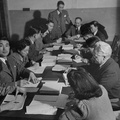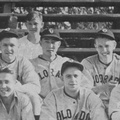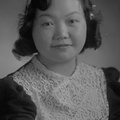Read Part 3 >>
Furthermore, on July 6, 1943, the instructors collectively signed a JLS faculty resolution thanking President Stearns and Captain Frank H. Roberts, USN for their efforts on behalf of the instructors and their families. The Silver & Gold also ran several editorials critical of the Denver Post’s hostile campaign against “Americans of Japanese Ancestry” or AJAS. In these editorials, student editorialists depicted EO 9066 as high handed, of doubtful legality, and as a poor portrayal of American democratic ideals, while citing the detention camp inmates in question were loyal American citizens.

“Sensei Relaxed Once in a While,” no date, Mrs. Nakamura, Ensho Ashikaga, “Big Chief” Susumu Nakamura, Rayer Toki, & Mrs. Toki, b&w, 3x4, Pineau06_05_00_03, Archives, University of Colorado Boulder Libraries.
While the Navy Language School’s students held their sensei in very high regard, instances of racism occurred in Boulder, as observed by both the students and instructors of the school. Most often, it seemed such antipathy occurred not from neighbors, or from those in constant proximity, but from those in casual and infrequent contact.1 Casual and directed racism toward Japanese Americans was not unusual in Boulder. Area newspapers carried vituperative editorials directed at the Japanese Americans in the Amache concentration camp, where relatives of some of the instructors of the U.S. Navy Japanese Language School were still incarcerated. One such editorial suggested the separation of male and female inmates, so that there would not be any more of them. One Japanese American instructor, when shopping for shoes in a Boulder shop, requested to see another pair, to which the merchant replied, “You’re lucky to be able to buy any.”2
If the yearbooks of 1943 to 1945 can provide a barometer of campus life for Japanese American students during the war, they show bleak readings. Despite increasing numbers and in stark contrast to prewar years, they are virtually absent from the class pictures and all but disappear from the rolls of student clubs, with the increasing exception of the Cosmopolitan Club. In 1943, 18 Japanese Americans made up 26 percent of the Cosmo Club membership rolls. In 1944, 24 Japanese Americans provided more than 40 percent of Cosmo Club members. In 1945 the percentage was down to 37 percent. Moreover, of the total Japanese American population on campus from 1942-1945, an average of 33 percent joined the club. These numbers only included those on the rolls who made it into the yearbook, and not all members and casual attendees. In the militarized campus where student portraits, fraternity composites, and group shots of clubs, honoraries, and student activities showed a majority in uniforms, Japanese Americans were either ignored by the yearbook, or chose on their own to withdraw from campus life.3
In 1943, Dean Dyde informed an absent President Stearns of his worries about a possible “anti-Japanese incident” in Boulder. He contacted Dr. C.L. Smith, of Boulder, who promised to try to prevent such an event from happening. Dyde also contacted the Denver Office of Naval Intelligence and filled them in on background information about the Boulder situation, hoping “that no foreground incidents would occur.” He also coordinated with Captain Roberts, who promptly made an appointment to meet Dr. Smith. What interested Dean Dyde, after discussing the matter with City Manager Harold McClintock, was the city manager’s belief that Dr. Smith was the likeliest candidate to instigate such an incident. Dr. Smith “either had a change of heart or at least a change of front.” Stemming such antipathy before it manifested itself kept Dean Dyde busy through the war years, as most other senior faculty were away performing war work.4
If the prominence of Japanese American students did not reflect their numbers, faculty can often influence students far beyond the classroom. The Japanese American sensei had a tremendous effect on the students who attended the U.S. Navy Japanese Language School. More than 1200 Caucasian men and women graduated from the school and served in Washington, DC, Pearl Harbor, Australia, and on islands throughout the Pacific, where they performed intelligence, translation, interpretation, POW interrogation and Occupation community affairs and research duties.
These graduates took the lessons they learned from their sensei and applied them through the humane treatment of thousands of Japanese POWs, displaced civilians, and the population of Occupied Japan. After the war, these former language officers came to dominate all academic fields of Japanese studies, the practice of diplomacy in the Pacific, as well as military, naval, and civilian intelligence regarding Asia for much of the rest of the century. When asked, many of these former language officers, professors, ambassadors, and intelligence officers attributed much of their compassion, concern, and curiosity for Japan and the Japanese to their time as Japanese language students and language officers, and to their sensei.5
Dan Williams wrote, “Our section head was Sensei John Yumoto, who did a superb job of advancing our understanding of both the Japanese language and Japan itself, and the majority of our time was spent with him,” and, “we JLS people seem forever connected to Japan.”6 Robert Sheeks maintained in speaking of Sensei Ari Inouye, “At Berkeley and Boulder, the childish burden of hostility toward Japanese influences not only was lifted from me, but I became a great admirer of Japan’s culture, and many aspects of Japanese traditional values and character.”7 Edward Hart summed up the prevailing view well.
I learned Japanese while in the US Navy during wartime. One might think that such circumstances would simply produce a pragmatic accommodation to the exigencies of the times, but the opposite was true. I embraced the opportunity to learn a new foreign language with all the avidity of an explorer entering a new world; and I believe the others of our group did the same thing.8
No small amount of this effect of the school was due to the sensei, which was brought home by testimonials to the sensei written and offered by the returning graduates at the USN JLS/OLS 60th Anniversary Reunion at the University of Colorado in 2002.9
The University administration had to steer a careful course between an expected anti-Japanese sentiment in Boulder and their own determination not to limit Japanese American Coloradan attendance. By establishing “quotas” for attendance, and employment, the Administration recognized Boulder’s wish not to accept unlimited numbers of Japanese Americans. It never seemed to matter that the total number of students never approached the imposed limit. Such legerdemain followed the established university pattern of upholding minority rights within a hostile environment. The success the university experienced with the Japanese American “problem” mirrored its earlier progress ameliorating segregation. It had been accomplished with little publicity, in closed door meetings with city fathers, with careful consideration of which strategy would work given the off campus attitudes.10
Japanese Americans fulfilled many public roles while at the University of Colorado. As students, they participated in honorary societies, clubs, student organizations, student government, the yearbook, student newspapers, and other publications. They were minority activists, peace advocates, and public speakers. Perhaps their most important role was as the sensei of more than 1200 U.S. Navy and Marine Corps Japanese language officers. In this role they filled the language officers with an admiration for Japanese culture, literature, and society, a respect and empathy for the Japanese people, and a curiosity about all things Japanese, within a wider American military and society, which held mainly views of fear, hatred and contempt.
Notes:
1. see Irish, 20-44; Regents Minutes, January 16, 1942-December 17, 1943, p. 214 and Exhibit G; Silver & Gold, November 6, 1942, 5; see the page 2 editorials in the Silver & Gold, April 27, April 30, May 7, May 18, 1943; “City, CU Agree on Restrictions of Japanese Aliens,” Boulder Daily Camera, January 20, 1943, 1; for a full description of the Japanese American Sensei experience, see Jessica N. Arntson, “Journey to Boulder: Japanese American Instructors of the Navy Japanese Language School (1942-1946)”, M. A. Thesis, East Asian Languages and Civilizations, University of Colorado Boulder, 2003 and Jessica N. Arntson, “Journey to Boulder: Japanese American Instructors of the Navy Japanese Language School (1942-1946),” in Arturo J. Aldama, Elisa Facio, Daryl Maeda, and Reiland Rabaka, eds., Enduring Legacies: Ethnic Histories and Cultures of Colorado, (Niwot, CO: University Press of Colorado, 2011), 175-93.
2. Donald Keene to David Hays, February 4, 2007, Donald Keene Collection, [Unprocessed], AUCBL.
3. For the concentration of Japanese Americans in the Cosmo Club, along with their disappearance from other activities, see the Coloradan, 1943, 1944, 1945.
4. W.F. Dyde to Robert L. Stearns, May 20, 1943, Robert L. Stearns Collection, 21-2, AUCBL.
5. See Dingman, Pp. 132-159, 194-248; Slesnick; Pp. 119-146; and Gerald Meehl, One Marine’s War: a Combat Interpreter’s Quest for Humanity in the Pacific, (Annapolis,MD: Naval Institute Press, 2012); the U.S. Navy Japanese/Oriental Language School Archival Project http://ucblibraries.colorado.edu/archives/collections/jlsp/index.htm; see The Interpreter, Issues. Reunion 2, #68a, #74a, #79a, #87, #151, #181; one merely has to consider the impact of the Freeman Foundation, Houghton Freeman having been a USN JLS graduate.
6. Dan S. Williams, “Reprise on Okamoto Sensei”, The Interpreter, #93a (November 15, 2005), p. 2; and #114, (August 1, 2007), p.1.
7. Robert Skeeks, “Reprise on Ari Inouye”, The Interpreter, #197 (July 1, 20014), p. 2.
8. Edward L. Hart. “The Need Beyond Reason,” More than Nature Needs, Charles E. Merrill Monograph Series, No. 10, BYU, p.80.
9. See the reunion issues of The Interpreter on http://ucblibraries.colorado.edu/archives/collections/jlsp/interpreters.htm.
10. Contemporary ambiguity and the range of opinion regarding Japanese Americans is discussed in Robert Redfield, “The Japanese Americans,” in William Fielding Ogburn, ed., American Society in Wartime (Chicago: University of Chicago Press, 1943), 143-64.
© 2014 David M Hays






